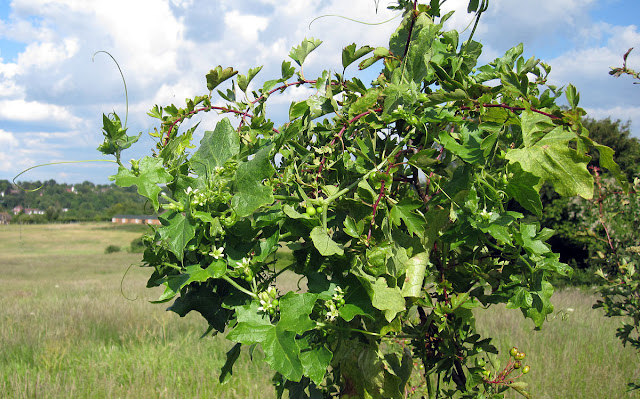 |
| Some of the Orpington Field Club oblivious to all around them. Next to Well Wood, 11 June 2011. |
Well Wood is not large, but it is big enough to contain several criss-crossing footpaths. It is bounded on two sides by houses, on the third by a road, and the fourth side opens onto farm fields. It has a "friends" group, and this turned out to be one of their work days. We met a small group emerging from the wood with saws and cutting tools. They had been clearing the paths. They were friendly and chatted with some of the OFC while we waited for everyone to arrive.
Walking into the wood, we saw some enchanter's nightshade, another new plant for me, a small spike with straggly white flowers. Then some iridescent brown-and-yellow micromoths were spotted on nettles. They were Nemophora degeerella, so-called longhorns. We saw some which did not have the expected long antennae, and I later found that these are the females.
 |
| Ten-spot Ladybird, Adalia decempunctata, on roadside foliage. Variant colour form. North Pole Lane, near Well Wood, 11 June 2011. |
We moved around the edge of the wood, seeing various unidentified flies, moths and bees; bracket fungi on fallen deadwood; and some of the small black fungi known as King Alfred's cakes because they look like burnt buns. As we approached the field side of the wood, we began to see more insects and some butterflies.
One of us spotted what looked like the nymph of a cricket. I saw some odd little twiggy bundles on bramble leaves, which were identified by our insect expert Graham as the larval case of a moth, Psyche casta. One distinctive-looking lacy-winged creature proved later to be a scorpion fly.
There were more and more butterflies and as we moved into the field it was suddenly sunny and warm. We began to see many large skippers and meadow browns, and the occasional small tortoiseshell. One clump of bramble was almost heaving with them. The plant life was, of course, very different out here as well. There were goat's-beards in the grass; no open flowers, as they close at mid-day, but many of the lovely seed heads, like bigger dandelions.
 |
| Meadow brown butterfly, Maniola jurtina, on bramble. Near Well Wood, 11 June 2011. |
In the hedgerow I saw more of the hedge woundwort that I had seen the morning of the same day in Jubilee Country Park. I couldn't resist bruising a leaf and inhaling the strong pungent smell.
We walked past a large and beautiful oak tree in which a chaffinch was singing loudly. Swifts circled round above the next field over. Magpies foraged in the long grass, in and out of sight among the stalks. I could see the hillside of West Wickham Common and Hast Hill in the distance. A small group of houses in the valley was the village of Nash. Although I live not far away, and had walked through and around Well Wood, I had never been down this footpath.
We reached a narrow country road and followed it for a while. By the end of the path was a clump of black horehound, very similar to hedge woundwort but without its smell. There were some Two-spot and Ten-spot Ladybirds in the hedgerow. The Ten-spot was a colour variant with red spots on a black background.
The road surface was liberally decorated with horse droppings, and indeed we were overtaken by two riders before we turned back through the fields to the wood. Things of interest were still turning up. Today the group had not split up as much as usual, but it was a straggling procession, and I have included a photo of part of the group completely engrossed in an identification. We were waiting for them to notice that we had turned off into the wood, and soon we were back at the car park.
I have added a couple of photos from this trip to my "unidentified" folder; a bee and a beetle. There is also a sawfly from Jubilee Country Park this morning.
 |
| Larval case of the moth Psyche casta on bramble leaf. Well Wood, 11 June 2011. |
 |
| Looking at a hedgerow near Well Wood. The village of Nash is visible to the far left. 11 June 2011. |
 |
| Large skipper, Ochlodes venatus, feeding on bramble flower. Male. Hedge next to Well Wood, 11 June 2011. |
 |
| Small tortoiseshell, Aglais urticae, and five meadow browns, Maniola jurtina, feeding on bramble near Well Wood. 11 June 2011. |
 |
| Scorpion fly, Panorpa species, female, on a nettle leaf in woodland. Well Wood, 11 June 2011. |
 |
| White bryony, Bryonia dioica, climbing over hawthorn near Well Wood, 11 June 2011. |
The photo of the group by a hedgerow, and the white bryony, were taken with my little Canon Ixus 100. All the others in this post were taken with my Canon EOS 450D and the Canon EF 100mm macro lens, often using a ring flash.
I was thinking, the figured landscape, "Looking at a hedgerow" (with Nash in left distance) is one of the finest English landscapes I've seen since Constable first painted Salisbury Plain. And then I see, at the bottom of the post, that it is a glorious advertisement for the Ixus 100.
ReplyDelete